|
|
|
Sort Order |
|
|
|
Items / Page
|
|
|
|
|
|
|
| Srl | Item |
| 1 |
ID:
171372


|
|
|
|
|
| Summary/Abstract |
The European Union has recently decided to stop the policy of biannual clock changes in 2021. One reason is that the original rationale for the policy, energy savings, is not supported by a large portion of recent empirical studies. Whether the new permanent time will be standard time or the former daylight saving time has not been decided. Evidence on energy savings from daylight saving time is country-specific, and each country may choose its own time. We examine the effects of the policy in a country for which no studies on daylight saving exist, Slovakia. Using hourly data from the 2010–2017 period, we apply a difference-in-differences approach and estimate energy savings to equal 1% of annual electricity consumption. Alternatively, extrapolating the effect from the results of a previous meta-analysis on different countries, for Slovakia we obtain a smaller estimate, unlikely to exceed 0.5%. Moreover, our findings suggest that daylight saving time smooths the electricity demand curve.
|
|
|
|
|
|
|
|
|
|
|
|
|
|
|
|
| 2 |
ID:
191366
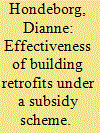

|
|
|
|
|
| Summary/Abstract |
While retrofitting buildings is one of the key elements of reaching climate and energy goals, it is burdened by insufficient speed and depth. Governments have attempted to accelerate deep retrofits via subsidies, but scant evidence exists on these policies’ effectiveness. In this study, we investigate the effectiveness of retrofitting subsidies by using a range of econometric techniques and a unique dataset of over 400 Swiss buildings with 19,000 observations over 11 years. Specifically, we analyze whether retrofits reduce energy consumption, whether subsidized retrofits lead to deeper retrofits than non-subsidized retrofits, and we differentiate the impact by subsidy amount. We find that retrofits reduce average energy use by 10–20%, that the achieved savings through subsidized and non-subsidized retrofits do not differ significantly, and that the subsidy amount is correlated to a reduction in energy use by 0.42 CHF per kWh over a period of 20 years. Our study highlights the importance of policies that enhance retrofit depth, the need to further investigate the causes of the wide variation in retrofitting results, and to consider effectiveness studies within the policy design.
|
|
|
|
|
|
|
|
|
|
|
|
|
|
|
|
| 3 |
ID:
192761
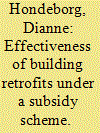

|
|
|
|
|
| Summary/Abstract |
While retrofitting buildings is one of the key elements of reaching climate and energy goals, it is burdened by insufficient speed and depth. Governments have attempted to accelerate deep retrofits via subsidies, but scant evidence exists on these policies’ effectiveness. In this study, we investigate the effectiveness of retrofitting subsidies by using a range of econometric techniques and a unique dataset of over 400 Swiss buildings with 19,000 observations over 11 years. Specifically, we analyze whether retrofits reduce energy consumption, whether subsidized retrofits lead to deeper retrofits than non-subsidized retrofits, and we differentiate the impact by subsidy amount. We find that retrofits reduce average energy use by 10–20%, that the achieved savings through subsidized and non-subsidized retrofits do not differ significantly, and that the subsidy amount is correlated to a reduction in energy use by 0.42 CHF per kWh over a period of 20 years. Our study highlights the importance of policies that enhance retrofit depth, the need to further investigate the causes of the wide variation in retrofitting results, and to consider effectiveness studies within the policy design.
|
|
|
|
|
|
|
|
|
|
|
|
|
|
|
|
| 4 |
ID:
090096
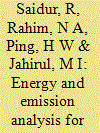

|
|
|
|
|
| Publication |
2009.
|
| Summary/Abstract |
The industrial sector is the largest user of energy in Malaysia. Industrial motors account for a major segment of total industrial energy use. Since motors are the principle energy users, different energy savings strategies have been applied to reduce their energy consumption and associated emissions released into the atmosphere. These strategies include using highly efficient motors, variable speed drive (VSD), and capacitor banks to improve the power factor. It has been estimated that there can be a total energy savings of 1765, 2703 and 3605 MWh by utilizing energy-efficient motors for 50%, 75% and 100% loads, respectively. It was also found that for different motor loads, an estimated US$115,936 US$173,019 and US$230,693 can be saved in anticipated energy costs. Similarly, it is hypothesized that a significant amount of energy can be saved using VSD and capacitor banks to reduce speed and improve the power factor, thus cutting energy costs. Moreover, a substantial reduction in the amount of emissions can be effected together with the associated energy savings for different energy savings strategies. In addition, the payback period for different energy savings strategies has been found to be reasonable in some cases.
|
|
|
|
|
|
|
|
|
|
|
|
|
|
|
|
| 5 |
ID:
091697
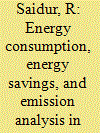

|
|
|
|
|
| Publication |
2009.
|
| Summary/Abstract |
This paper is concerned with the estimation of energy use in office buildings in Malaysia and with the energy use of major equipment. Energy intensity (EI) - a measure of a building's energy performance - is estimated for Malaysia and compared with a number of selected countries. Air conditioners are shown to be the major energy users (57%) in office buildings, followed by lighting (19%), lifts and pumps (18%) and other equipment (6%). It is estimated that 77,569 MWh of energy can be saved and a huge reduction of emissions achieved through the application of advance glazing, compact fluorescent lamps (CFL), insulation, housekeeping, and by raising thermostat set point temperature of air conditioners, and reducing EI.
|
|
|
|
|
|
|
|
|
|
|
|
|
|
|
|
| 6 |
ID:
094894
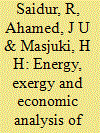

|
|
|
|
|
| Publication |
2010.
|
| Summary/Abstract |
In this paper, the useful concept of energy and exergy utilization is analyzed, and applied to the boiler system. Energy and exergy flows in a boiler have been shown in this paper. The energy and exergy efficiencies have been determined as well. In a boiler, the energy and exergy efficiencies are found to be 72.46% and 24.89%, respectively. A boiler energy and exergy efficiencies are compared with others work as well. It has been found that the combustion chamber is the major contributor for exergy destruction followed by heat exchanger of a boiler system. Furthermore, several energy saving measures such as use of variable speed drive in boiler's fan energy savings and heat recovery from flue gas are applied in reducing a boiler energy use. It has been found that the payback period is about 1 yr for heat recovery from a boiler flue gas. The payback period for using VSD with 19 kW motor found to be economically viable for energy savings in a boiler fan.
|
|
|
|
|
|
|
|
|
|
|
|
|
|
|
|
| 7 |
ID:
175256


|
|
|
|
|
| Summary/Abstract |
Energy efficiency is one of the key goals in energy and climate policies. However, it is known to be difficult to define and measure. In the literature, there are many debates on the appropriate way to measure energy efficiency performance for policy development. There is also a fair share of confusion over how different energy efficiency performance estimates should be interpreted. We discuss the sources of contention by examining different definitions, methods, measures and policy objectives that are used to evaluate energy efficiency. The objective is to present the different results and purposes in a systematic manner within the broader end goal of improving national energy efficiency. A clearer picture of the underlying assumptions, boundaries and perspectives behind energy efficiency performance is important for policy assessment. With this larger goal in mind, we conclude that policymakers are free to choose any definition, method and measure for analysis. However, results should be interpreted with respect to the method, assumptions, limitations and context that they were developed for. Specifically, differences in results at different levels of analysis should be studied in detail to understand the challenges faced in translating efficiency improvements at the device, process and sub-sector levels to national level improvements.
|
|
|
|
|
|
|
|
|
|
|
|
|
|
|
|
| 8 |
ID:
150825
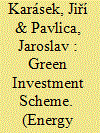

|
|
|
|
|
| Summary/Abstract |
The key goal of this study was to analyse application of the Green Investment Scheme in the Czech Republic through the Green Savings Programme finalising in 2015. The programme was evaluated in terms of aspects of both reduction effectiveness and economic aspects of the basic subsidy categories: (a) Insulation; (b) Low-Energy Houses; (c) Biomass Boilers; (d) Solar Thermal Systems and (e) Heat Pumps. The essential results of the programme were also covered, including the number of projects supported, the total volume of emission reduction and the volume of financial funding.
|
|
|
|
|
|
|
|
|
|
|
|
|
|
|
|
| 9 |
ID:
137681
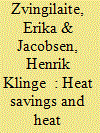

|
|
|
|
|
| Summary/Abstract |
The trade-off between investing in energy savings and investing in individual heating technologies with high investment and low variable costs in single family houses is modelled for a number of building and consumer categories in Denmark. For each group the private economic cost of providing heating comfort is minimised. The private solution may deviate from the socio-economical optimal solution and we suggest changes to policy to incentivise the individuals to make choices more in line with the socio-economic optimal mix of energy savings and technologies.The households can combine their primary heating source with secondary heating e.g. a woodstove. This choice results in increased indoor air pollution with fine particles causing health effects. We integrate health cost due to use of woodstoves into household optimisation of heating expenditures.The results show that due to a combination of low costs of primary fuel and low environmental performance of woodstoves today, included health costs lead to decreased use of secondary heating. Overall the interdependence of heat generation technology- and heat saving-choice is significant. The total optimal level of heat savings for private consumers decrease by 66% when all have the option to shift to the technology with lowest variable costs.
|
|
|
|
|
|
|
|
|
|
|
|
|
|
|
|
| 10 |
ID:
176802


|
|
|
|
|
| Summary/Abstract |
An expanding body of research is defining drivers, benefits, and challenges of adopting ISO 50001 energy management systems. The Clean Energy Ministerial's Energy Management Leadership Awards program requires ISO 50001-certified organizations to develop case studies of their implementation experience. 72 recent case studies spanning multiple economic sectors provide a unique global look at implementation from certified organizations' perspectives. This dataset was investigated through content analysis of phrases related to motivations and goals, the role of management and the organization, benefits achieved, keys to success, and challenges. This paper presents findings from this quantitative analysis of “codes” assigned to phrases that capture their meaning. While organizations adopted ISO 50001 for different motives and saw myriad benefits beyond energy savings and associated greenhouse gas emissions reductions, commonalities exist. The most frequently identified drivers are existing values and goals, environmental sustainability, and government incentives or regulations. Findings also include: obtaining and sustaining top management support is critical; top benefits mentioned are cost savings, productivity, and operational improvements; and the primary barrier is lacking a culture of energy management. Policymakers and others looking to accelerate ISO 50001 uptake can use these findings to highlight benefits and incentives that will resonate with corporate decisionmakers worldwide.
|
|
|
|
|
|
|
|
|
|
|
|
|
|
|
|
| 11 |
ID:
109704


|
|
|
|
|
| Publication |
2011.
|
| Summary/Abstract |
Europe's 2020 greenhouse gas (GHG) reduction target consists of two sub-targets: one for the Emissions Trading Scheme (ETS) sectors and one for the non-ETS sectors. The non-ETS target covers CO2 emissions in buildings, transport and non-ETS industry and non-CO2 GHG emissions. The non-ETS target is known as Europe's Effort Sharing Decision. This article discusses the GDP per capita method the European Commission has applied in setting Member State specific targets for the non-ETS ("the effort sharing") and shows that it results in an imbalanced reduction effort among the Member States. It turns out that the principal mechanism of the GDP per capita method (low-GDP countries get room to catch up with high-GDP countries by allowing them to increase emissions) is obscured by the non-CO2 GHGs, the baseline projections of which are highly policy-induced and not correlated with the growth of GDP per capita. We propose an alternative method that (1) corrects for the policy-induced decrease of non-CO2 GHG emissions and (2) is based on energy savings potentials. This approach could be used in future target setting for non-ETS sectors - including in the case that the overarching EU-wide target would be strengthened - and would provide a direct support to Europe's energy savings ambitions and policies.
|
|
|
|
|
|
|
|
|
|
|
|
|
|
|
|
| 12 |
ID:
119785


|
|
|
|
|
| Publication |
2013.
|
| Summary/Abstract |
A substantial untapped energy saving potential rests in the building sector and is expected to play an important role in achieving reduction of environmental impacts of energy. In order to utilise this potential, effective policy measures need to be adopted to remove the existing barriers and create incentives. For that purpose, the cost effective energy saving options together with an optimal level of savings and expected environmental benefits have to be identified. The paper reports on a study that analyses these questions by including heat-saving measures in buildings into an energy system optimisation model of the Danish heat and power sector. The achieved optimal level of heat savings reaches 11% of projected heat demand in 2025 under the model assumptions. Moreover, the analysis reveals the importance of considering energy conservation options in a system wide perspective. Furthermore, the results suggest that changes in the energy generation sector are the prime driver behind the reduction of environmental externalities of energy. Heat savings in buildings play only a small role under model assumptions.
|
|
|
|
|
|
|
|
|
|
|
|
|
|
|
|
| 13 |
ID:
162963


|
|
|
|
|
| Summary/Abstract |
This paper reviews China’s achievements in energy efficiency improvements and air emissions reductions from the electric power sector during the 11th five-year plan (FYP) (2006–2010) and 12th FYP (2011–2015) periods, and discusses the remaining challenges and opportunities for policy formulation. Mandates for closure of small coal-fired power plants (CFPPs), and replacement with large ones, together with the promulgation of air emissions standards and the development of renewable energy projects, have resulted in an improvement of 15% in energy efficiency and a reduction of 91%, 89% and 96% in emission rates of SO2, NOx and PM from China’s electric power sector over the last decade. Compared to the United States, the Chinese electric power generation fleet is more energy efficient and has lower average emissions rates of SO2 and NOx. Despite these achievements, two characteristics of the current system pose serious challenges for China’s clean power development: a) two thirds of China’s power generation still rely on coal, and more CFPPs are being built and approved to be built; and b) high curtailment of renewable energy limits its benefits. We review the root causes of these challenges and highlight opportunities for enacting policies to address them.
|
|
|
|
|
|
|
|
|
|
|
|
|
|
|
|
| 14 |
ID:
101397


|
|
|
|
|
| Publication |
2011.
|
| Summary/Abstract |
Global butter, concentrated milk, and milk powder products use approximately 15% of annual raw milk production. Similar to cheese and fluid milk, dairy processing of these products can be energy intensive. In this paper, we analyzed production and energy data compiled through extensive literature reviews on butter, concentrated milk, milk and whey powder processing across various countries and plants. Magnitudes of national final and primary specific energy consumption (SEC) exhibited large variations across dairy products; in addition, the final SEC of individual plants and products exhibited significant variations within a country and between countries. Furthermore, we quantified national energy intensity indicators (EIIs) accounting for dairy product mixes and technological advancement. The significant variations of SEC and EII values indicate a high degree of likelihood that there is significant potential for energy savings in the global dairy processing industry. Based upon the study samples, we estimate potential energy savings for dairy processing industry in selected countries, and estimates annual reduction of 9-14 million metric-ton carbon-equivalent1 could be achieved if measures are implemented to lower SEC values by 50-80% in half of global dairy plants. The paper calls for publication of more energy data from the dairy processing industry.
|
|
|
|
|
|
|
|
|
|
|
|
|
|
|
|
| 15 |
ID:
121308


|
|
|
|
|
| Publication |
2013.
|
| Summary/Abstract |
Financial incentives are important for overcoming certain market barriers to improved energy efficiency and for the adoption of energy efficient technologies. Financial incentives are mainly focused on the introduction of specific technologies, rather than behavioural change. While the declared goal of financial support schemes very often is to save energy or reduce harmful emissions rather than to foster new technologies per se, it is often encountered that such financial support for energy efficient technologies may not ensure real energy savings due to the rebound effect and various market barriers.
In the area of renewable energies it is common for financial support to be given to power producers for the verified production of renewable electricity, in the form of a guaranteed financial incentive (feed-in tariff). In the energy efficiency policy research little attention has been paid to the possible use of a "feed-in tariff" in the form of a financial incentive based on the kWh saved by the end-user. This paper discusses the possible setup of a feed-in tariff designed to reward energy savings.
|
|
|
|
|
|
|
|
|
|
|
|
|
|
|
|
| 16 |
ID:
119801


|
|
|
|
|
| Publication |
2013.
|
| Summary/Abstract |
Energy policies at the urban level may result in long lasting effects and can successfully influence the energy performances of an urban system if we consider the whole built environment and focus on the energy renovation process in existing buildings. Undoubtedly, cities have a high level of complexity, especially considering problems related to obtaining suitable information about a building's energy performance and consumption.
This study developed a methodology able to characterize the energy performance of the built environment in a city or neighbourhood and to evaluate the effects of different energy strategies. The methodology was designed to be as simple as possible, not time consuming and applicable to all Italian towns, as well as elsewhere, if basic building information are available; the main phases of the methodology were the collection and analysis of the available data about the built environment and the implementation of a Geographic Information Systems (GIS) city buildings database. To test the developed tool, the city of Milan was considered as a case study.
The authors hope that this methodology will be able to support energy policies at the urban level, taking into account the approaches of different stakeholders to develop low carbon models of settlements.
|
|
|
|
|
|
|
|
|
|
|
|
|
|
|
|
| 17 |
ID:
068420


|
|
|
| 18 |
ID:
105760


|
|
|
|
|
| Publication |
2011.
|
| Summary/Abstract |
We show that renewable energy contributes to Europe's 2020 primary energy savings target. This contribution, which is to a large extent still unknown and not recognized by policy makers, results from the way renewable energy is dealt with in Europe's energy statistics. We discuss the policy consequences and argue that the 'energy savings' occurring from the accounting of renewable energy should not distract attention from demand-side energy savings in sectors such as transport, industry and the built environment. The consequence of such a distraction could be that many of the benefits from demand-side energy savings, for example lower energy bills, increase of the renewable energy share in energy consumption without investing in new renewable capacity, and long-term climate targets to reduce greenhouse gas emissions by more than 80%, will be missed. Such distraction is not hypothetical since Europe's 2020 renewable energy target is binding whereas the 2020 primary energy savings target is only indicative.
|
|
|
|
|
|
|
|
|
|
|
|
|
|
|
|
| 19 |
ID:
104963


|
|
|
|
|
| Publication |
2011.
|
| Summary/Abstract |
Anthropogenic material and energy flows are considered to be the major cause of many environmental problems humans face today. In order to measure material and energy flows, and to mitigate related problems, the technique of material flow and energy flow analysis has been conceived. The aim of this article is to use material and energy flow accounting approaches to quantify the amount of biomass that is available, but that so far has not been used for energy purposes in Slovakia and the Czech Republic and to calculate how much consumed fossil fuels and corresponding CO2 emissions can be saved by utilising this biomass. Based on the findings presented, 3544 kt/yr of the total unused biomass in Slovakia could replace 53 PJ/yr of energy from fossil fuels and 6294 kt/yr of the total unused biomass in the Czech Republic could replace 91 PJ/yr of energy. Such replacement could contribute to a decrease in total CO2 emissions by 9.2% in Slovakia and by 5.4% in the Czech Republic and thus contribute to an environmental improvement with respect to climate change.
|
|
|
|
|
|
|
|
|
|
|
|
|
|
|
|
| 20 |
ID:
110392


|
|
|
|
|
| Publication |
2011.
|
| Summary/Abstract |
A number of Member States of the EU have introduced voluntary agreements (VAs) that aim to deliver energy savings and emission reductions via increased energy efficiency in different end-use sectors, mainly targeting industry.
Where there is a successful track record of cooperation between public authorities and the private sector, VAs can offer advantages to public authorities in comparison to legislation, most importantly better flexibility when introduced or updated, greater acceptance by industry, possibility for tailor-made solutions e.g. at the level of industrial sectors and opportunity to overcome the information asymmetry between public authorities and private actors. Nevertheless, VAs have been criticized for lack of specific obligations and lenient targets, as well as for deficiencies in compliance monitoring and self-reporting and difficulty in establishing the policy additionality of VA activity.
This paper analyses the design of existing VAs in terms of general framework, targets and sectors, obligations and commitments, motivation to join, reporting and monitoring provisions, and results of existing VAs as reported by national authorities. The paper summarizes the key characteristics of voluntary agreements and gives recommendations for the successful application of this policy tool.
|
|
|
|
|
|
|
|
|
|
|
|
|
|
|
|
|
|
|
|
|